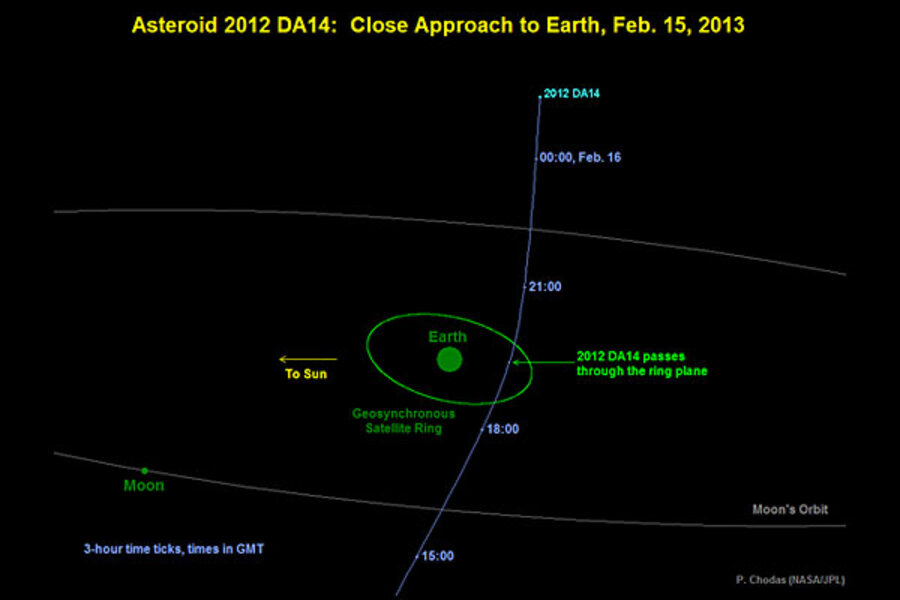Earth-buzzing asteroid: Big enough to level a city, it was found by amateurs
Loading...
The solar system is sending Earth a fleeting Valentine's greeting in the form of asteroid 2012 DA14, which makes a whisker-close (cosmically speaking) approach on Feb. 15.
The rocky asteroid, which measures roughly 150 feet across, is predicted to pass within 17,000 miles of Earth's surface, slipping below the 22,236-mile altitude where major weather and communications satellites operate, but well above low-Earth orbit, where the International Space Station and the vast majority of satellites hurtle around the planet.
Its close encounter with Earth is expected to shift its orbit enough to shave 51 days off of its current 368-day orbital period.
Asteroid specialists note that the object presents no threat to either Earth or satellites, although for the record, experts currently calculate a 1 in 7.5 million chance it could strike our planet in February 2110.
Next week's fly-by represents a record – the closest that a known object of this size has buzzed the planet, according to Paul Chodas and Don Yeomans, astronomers at NASA's Jet Propulsion Laboratory who study asteroids and the potential hazards they pose.
Objects in this size class come this close about once every 40 years, on average, and collide with Earth at an average rate of one every 1,200 years, they say.
Such an event wouldn't be a civilization buster, but it could put a world of hurt on a major metropolitan area, suggests Bruce Betts, director of projects for the Planetary Society in Pasadena, Calif.
In 1908, a similarly sized object plummeted through the atmosphere and burst above the Siberian forest near the Podkamennaya Tunguska River, some 480 miles northeast of Krasnoyarsk. The air-burst flattened an estimated 80 million trees in a blast zone that covered 830 square miles, comparable in size to Louisville, Ky., or San Diego, Calif.
"This would have leveled a city," says Dr. Betts.
Since astronomers began efforts dedicated to the search for near-Earth objects around 1995, some 9,668 have been discovered. Of those, 861 are more than half a mile wide, while 1,373 are considered potentially hazardous.
By some estimates, the number of asteroids in the 20-meter (65.6 feet) to 200-meter (656 feet) size range could reach as high as 500,000.
Asteroid 2012 DA14 was discovered last year by a team of dedicated amateur astronomers operating a small observatory in the mountains of southern Spain. The effort highlights the role more-sophisticated amateurs can play in hunting for near-Earth objects, especially those that pose a threat to Earth.
Using a high-speed camera bolted to the back of an 18-inch telescope, the team, led by Jaime Nomen, a Barcelona dental surgeon, first detected the asteroid last February. The group is hunting for the smaller objects that are so faint that they don't appear until perhaps a week before closest approach.
"These small objects can appear at any moment," says Dr. Nomen, who notes that he has cut his once full-time dental practice down to two days a week to allow for more observing and more-rapid processing of the images the telescope takes.
Indeed, he and his team discovered another object much like 2012 DA14 on Feb. 4 and are awaiting confirmation of the siting from other observatories, he said in a briefing with reporters on Tuesday. Initial calculations of the object's orbit suggest it won't pass as close to Earth as 2012 DA14. Two days ago, calculations suggested that the object, estimated at 100 to 130 feet across, would make its closest approach to Earth some 72,000 miles beyond the moon.
Moonlit nights and bouts of cloudy weather slow the pace of discovery of objects in ths size range.
"There are a lot of reasons [why] it's possible still to discover many of those objects, even working with small devices as we have," he says.
The team, which runs the La Sagra Observatory and its three 18-inch telecopes, were able to add the high-speed camera to one of them thanks to a grant from the Planetary Society in a program aimed at upgrading the hardware that hard-core amateur astronomers use to hunt for near-Earth objects.
While professional observatories dedicated to such searches bag the highest number of asteroids, perhaps as many as 100 amateurs worldwide conduct the follow-up observations needed to refine calculations of an object's orbit, figure out if an asteroid has a companion, and provide some initial characterizations of the type of asteroid the professionals discover, Betts says.






